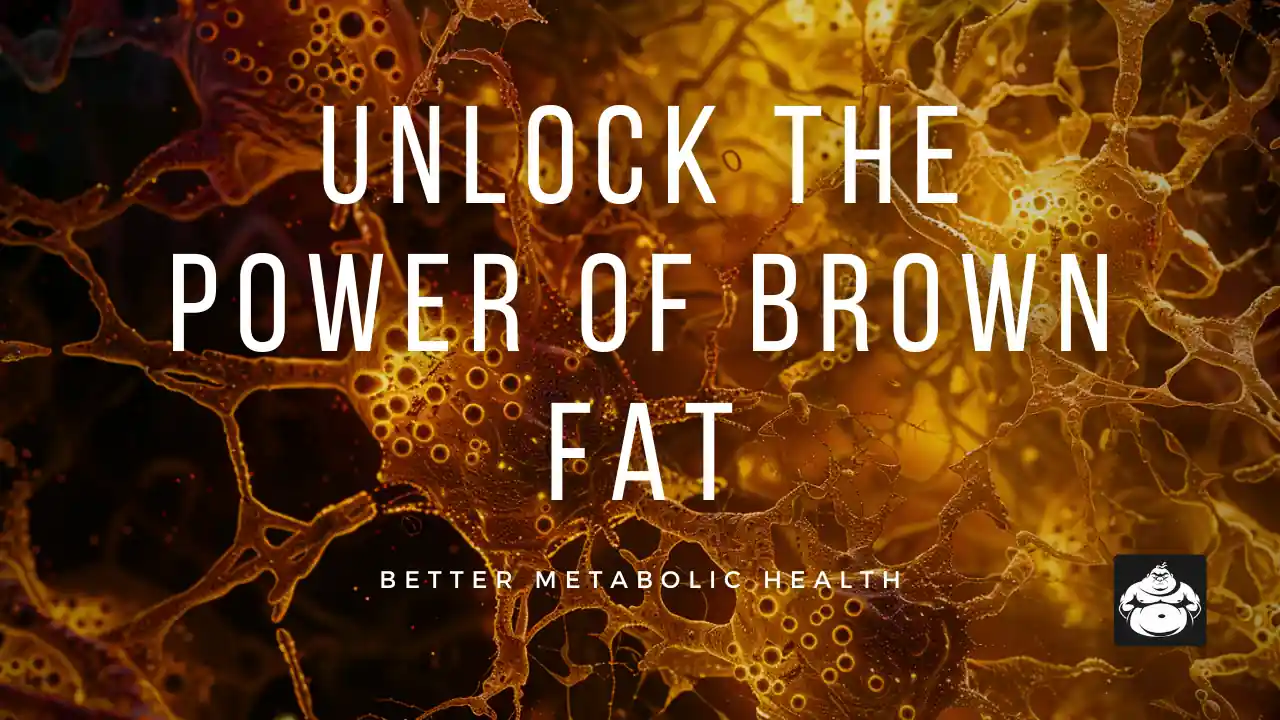Brown Fat: Your Body's Secret Weapon for Burning Calories
Discover the surprising role of brown adipose tissue in metabolism and weight management—could it be the key to unlocking better health?

You might be surprised to learn that not all fat in your body serves the same purpose. Brown adipose tissue, or brown fat, is quite different from the white fat that most people think of when discussing body weight. This specialized tissue is designed to generate heat and burn calories, playing a crucial role in your metabolism.
Understanding its unique characteristics and functions could reveal significant revelations about your health and weight management. So, what exactly sets brown fat apart, and how might it impact your overall well-being?
Brown Adipose Tissue: The Heat-Generating Fat
Brown adipose tissue (BAT) is your body's specialized fat that generates heat and burns energy through thermogenesis. Unlike white fat, BAT contains more mitochondria, which are responsible for calorie burning and energy expenditure.
This unique fat is activated primarily by cold exposure and physical activity, playing a vital role in maintaining metabolic health. By helping regulate blood sugar levels and increasing calorie burning, BAT can lower body fat percentages.
Unique Features of Brown Fat: Structure and Function
When you look at brown fat, you'll notice it has a unique structure that sets it apart from white fat.
Its high mitochondrial density and smaller fat droplets allow for efficient energy burning, which plays a key role in its metabolic functions.
Understanding these characteristics helps you appreciate how brown fat contributes to thermogenesis and overall energy balance in your body.
Brown vs. White Fat: Key Structural Distinctions
BAT's structural composition features multilocular fat vacuoles and a high density of mitochondria, which together facilitate efficient thermogenesis and energy expenditure.
One of the main differences between brown adipose tissue and white adipose tissue is the size and number of lipid droplets; BAT has smaller droplets, contributing to its darker color because of more iron-rich mitochondria.
Brown adipocytes typically range from 15-60 μm, making them smaller than the 25-200 μm size of white adipocytes.
Furthermore, BAT is highly vascularized, ensuring a rich blood supply that supports its metabolic functions.
The presence of uncoupling protein-1 (UCP-1) in the mitochondria allows for non-shivering thermogenesis, where energy production is directed in the direction of heat generation instead of ATP synthesis.
Brown Fat's Role in Metabolism and Energy Expenditure
The unique structural features of brown adipose tissue support its remarkable metabolic functions, primarily through thermogenesis and energy expenditure.
Brown adipose tissue relies on its high mitochondrial density and uncoupling protein-1 (UCP-1) to generate heat by burning glucose and fatty acids. This process is essential for thermoregulation, especially in cold exposure.
Activating brown fat increases caloric burn, which can enhance your metabolic health. People with more brown fat often show better insulin sensitivity and lower levels of triglycerides and cholesterol, reducing their risk of obesity-related diseases.
Health Benefits of Brown Fat: Beyond Temperature Regulation
Brown adipose tissue (BAT) plays an essential role in generating heat and maintaining body temperature, especially in cold environments, through a process known as non-shivering thermogenesis.
When you're exposed to cold, BAT activates and boosts your metabolic activity, leading to increased caloric expenditure. This not just helps you stay warm but also enhances insulin sensitivity, making BAT a potential ally against metabolic disorders like obesity and type 2 diabetes.
Cold exposure stimulates the release of beneficial hormones such as irisin and adiponectin, which improve metabolic health.
Research shows that higher levels of BAT correlate with better cardiovascular health by lowering plasma triglycerides and cholesterol levels, distinguishing it from white fat, which doesn't have these benefits.
Brown Fat vs. White Fat: A Comparative Analysis
Understanding the differences between brown fat and white fat is essential for appreciating their distinct roles in metabolism and overall health.
Brown adipose tissue (BAT) specializes in energy expenditure and thermogenesis, helping you burn calories, while white adipose tissue (WAT) mainly stores energy.
BAT has many mitochondria and multilocular lipid droplets, giving it a darker color, whereas WAT has fewer mitochondria and larger droplets, resulting in a lighter appearance.
People with higher BAT levels often have lower body fat percentages and better insulin sensitivity, leading to improved metabolic health.
On the other hand, excess WAT, especially visceral fat, increases the risk of metabolic disorders like type 2 diabetes and heart disease, highlighting the importance of maintaining a healthy balance between these two types of body fat.
Activating Brown Fat: Techniques and Triggers
Cold exposure is one of the most effective ways to activate brown adipose tissue (BAT), kickstarting your body's energy expenditure and thermogenesis.
You can also enhance brown fat activity through physical activity, which increases metabolism and helps burn calories.
Furthermore, certain dietary components, like capsaicin found in chili peppers, can improve brown fat function and support weight management.
Techniques like ice baths or cold showers can further stimulate the production of brown adipose tissue, promoting overall metabolic health.
Keep in mind, maintaining good sleep patterns is essential, too, as disrupted sleep could reduce the effectiveness of your brown fat.
Brown Fat's Impact on Overall Health and Disease Prevention
Brown adipose tissue (BAT) plays an essential role in reducing obesity risk and improving your metabolic health.
By increasing calorie burning and regulating blood sugar levels, having more BAT can help you maintain a healthier weight and lower your chances of developing conditions like type 2 diabetes.
Furthermore, higher BAT levels can lead to better cholesterol and triglyceride profiles, supporting overall cardiovascular wellness.
How Brown Fat Helps Combat Obesity and Related Diseases
Higher levels of brown adipose tissue (BAT) markedly lower your risk of obesity-related diseases by boosting calorie burning and improving metabolic health.
BAT is metabolically active, meaning it burns calories even when you're at rest. This helps enhance insulin sensitivity, which is essential for weight management. Here's how BAT impacts your health:
| Benefit | Effect on Health | Relevance to Obesity |
|---|---|---|
| Energy Expenditure | Increases calorie burning | Reduces fat accumulation |
| Insulin Sensitivity | Improves glucose regulation | Lowers diabetes risk |
| Cardiovascular Health | Reduces triglycerides and cholesterol | Lowers heart disease risk |
| Weight Management | Aids in maintaining healthy weight | Prevents obesity |
| Therapeutic Target | Potential for obesity treatments | Offers new treatment avenues |
Boosting Metabolic Health Through Brown Fat Activation
The role of brown adipose tissue (BAT) in boosting calorie burning not just aids in obesity prevention but also greatly enhances metabolic health by improving insulin sensitivity and glucose metabolism.
Cold exposure can activate BAT, leading to increased energy expenditure and improved glucose homeostasis. This activation also helps reduce plasma triglycerides and cholesterol levels.
Additionally, higher levels of beneficial hormones, such as irisin and adiponectin, are linked to active BAT, promoting weight management.
Disorders and Aging: How They Affect Brown Fat Function
Conditions like anorexia nervosa and obesity can greatly impact the function of brown adipose tissue, leading to impaired energy regulation and increased metabolic risks.
Here are four key effects these conditions can have on your body:
- Reduced thermogenic capacity: Less brown fat means less heat production, making it harder to maintain body temperature.
- Impaired glucose metabolism: Obesity and insulin resistance can hinder the brown fat's ability to process sugar effectively.
- Increased metabolic disorders: Conditions like type 2 diabetes can emerge from the decreased function of brown fat.
- Aging effects: As you age, the amount and activity of brown adipose tissue decline, contributing to weight gain and metabolic decline.
Understanding these conditions helps you recognize their impact on your overall health.
Cutting-Edge Research: The Future of Brown Fat in Medicine
Ongoing research is uncovering exciting possibilities for harnessing brown adipose tissue's unique properties to combat metabolic disorders. Scientists are exploring genetic factors and environmental influences that affect BAT development and function.
They're also investigating how pharmacological agents can stimulate BAT activation to utilize its calorie-burning potential for treating obesity.
| Research Focus | Key Findings | Future Implications |
|---|---|---|
| Cold Exposure | Enhances thermogenesis | Potential obesity treatment |
| Gut Microbiota | Influences BAT function | Links to metabolic health |
| Trpv1 Receptor | Involved in energy-expending BAT | New strategies for BAT increase |
Future studies aim to clarify these mechanisms, providing hope for innovative approaches to tackle obesity and related metabolic disorders.
Practical Strategies to Boost Your Brown Fat Levels
How can you effectively increase brown fat to boost your metabolism and overall health? Here are some practical ways to enhance brown fat activation:
- Cold Exposure: Try ice baths or cold showers to stimulate thermogenic activity and increase calorie burning.
- Physical Activity: Engage in regular exercise, which promotes brown fat activation and improves metabolic health.
- Dietary Factors: Incorporate foods high in capsaicin, like chili peppers, and catechins from green tea to support brown fat function.
- Adequate Sleep: Maintain healthy sleep patterns, as good sleep can positively influence brown fat activity and hormonal influence.





